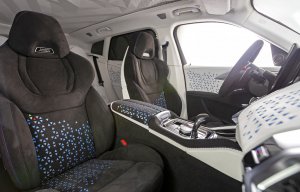
Alcantara to the max for BMW Italia
Vehicle designers and engineers, who place great importance on the design of the interior, and in particular the seats, are supported by the scientists from the Hohenstein Institute in Boennigheim, Germany.

18th December 2013
Innovation in Textiles
|
Boennigheim
Vehicle designers and engineers, who place great importance on the design of the interior, and in particular the seats, are supported by the scientists from the Hohenstein Institute in Boennigheim, Germany.
Optimally designed vehicle seats make an important contribution to road safety, researchers suggest. They support the driver's mental and physical performance, in particular on long journeys.

The researchers at the Hohenstein Institute have established four key characteristics which determine the physiological comfort of vehicle seats: initial heat flow, breathability, heat insulation and moisture buffering.
All these factors are evaluated in the Hohenstein Institute laboratories and they provide manufacturers with information for improving design and material selection.
High temperatures combined with moisture make the interior of vehicles a potential breeding ground for bacteria and fungi, particularly in the summer. Microorganisms can lead to unpleasant odours, cause problems for allergy suffers and significantly reduce the durability of the interior equipment.

The Hohenstein experts conduct realistic tests on the effectiveness of antimicrobial finishes to determine how well textiles, plastics and other surfaces prevent the accumulation of microorganisms.
Standardised laboratory tests are also used to evaluate the effectiveness of antiviral finishes. To break chains of infection, products in the public sphere are already being used with an antiviral finish.
The increasing number of allergy suffers and individuals with sensitivities is also posing new challenges for car manufacturers. The vehicle interior must be kept permanently free of harmful substances and allergens.
Therefore, the accumulation of microorganisms and the inflow from outside must be prevented. Within the framework of the harmful material tests in accordance with Oeko-Tex Standard 100, more than 100 parameters are investigated for the materials at the Hohenstein Institute.

The Institute offers effect-related tests on the biological safety of products, such as seat coverings. With the help of a simple in-vitro cell culture test, allergenic potential is recorded for the use of unknown dyes, dye components or other chemicals.
The combinations of crude-oil-based materials that are less biologically degradable, as well as the antimicrobial finishes that make good sense from a hygiene point of view, can become problematic at the end of a vehicle's life. They often prevent the rapid and non-residue decomposition of the interior equipment and add-ons.
To ensure a balance between these factors, material properties must be precisely analysed and optimised. In realistic models, the microbiologists at the Hohenstein Institute contaminate the test samples with voracious moulds. The material is then analysed to determine negative changes.
To have an interior that is pleasantly cool in summer, but cosy and warm in winter, effective thermal insulation of the windows is particularly important, alongside the air conditioning.

Based on standard DIN EN 410 ‘Glass in building’, the experts from the Hohenstein Institute therefore calculate the ‘g-value’ as the measure for the energy transmittance of materials.
The extent to which a textile material has a sound-absorbing effect and what sounds are caused by wind flow is tested at the Hohenstein Institute using acoustic test apparatus, which determines how well a material is able to reduce or absorb sound.

The aero-acoustic test, on the other hand, examines the frequency spectra in which the materials themselves generate sound when they are subjected to air flow.
Experts suggest that the majority of complaints from customers due to colour deviations could be avoided. The use of instrumental and visual colour analysis can ensure that the colour effect will correspond to the target values even on different materials and surfaces.
Instrumental colour measurement uses a ‘spectral photometer’ to determine the spectral reflection of test samples. This means the process examines which portions of white light are reflected by a material sample, establishing colour perception in the human eye.

Business intelligence for the fibre, textiles and apparel industries: technologies, innovations, markets, investments, trade policy, sourcing, strategy...
Find out more